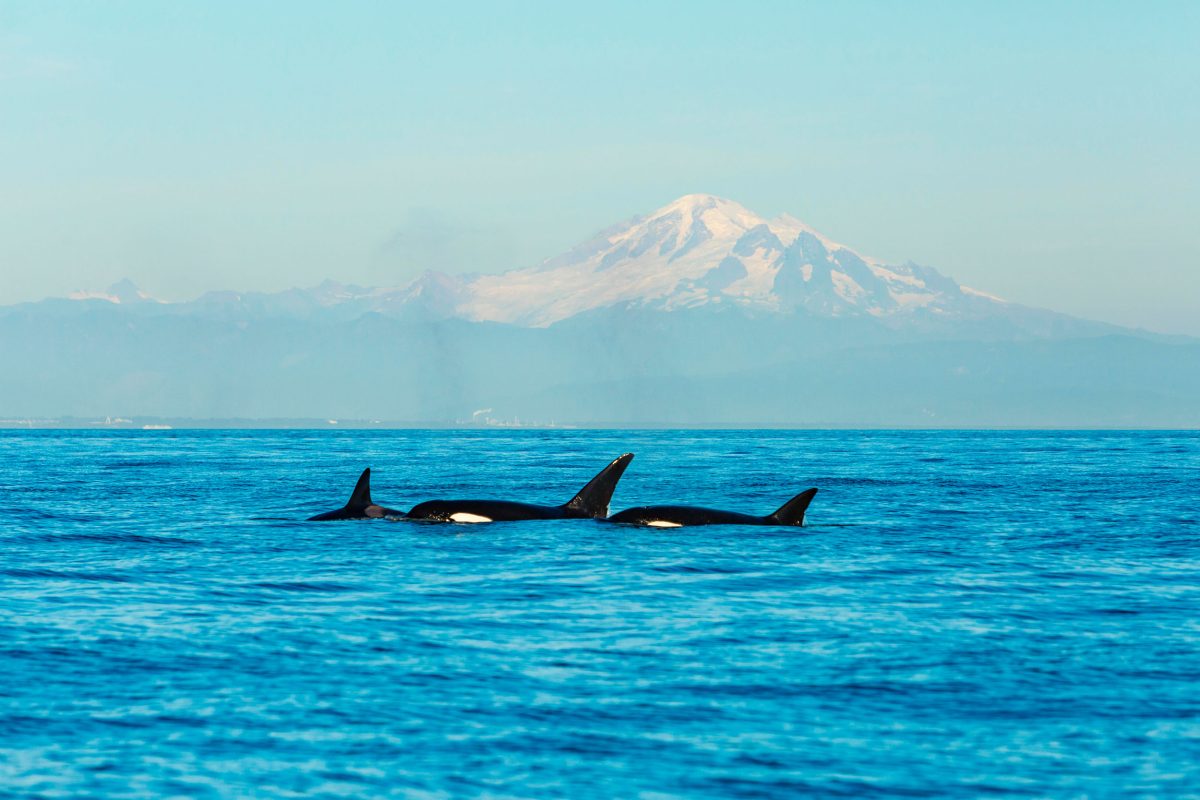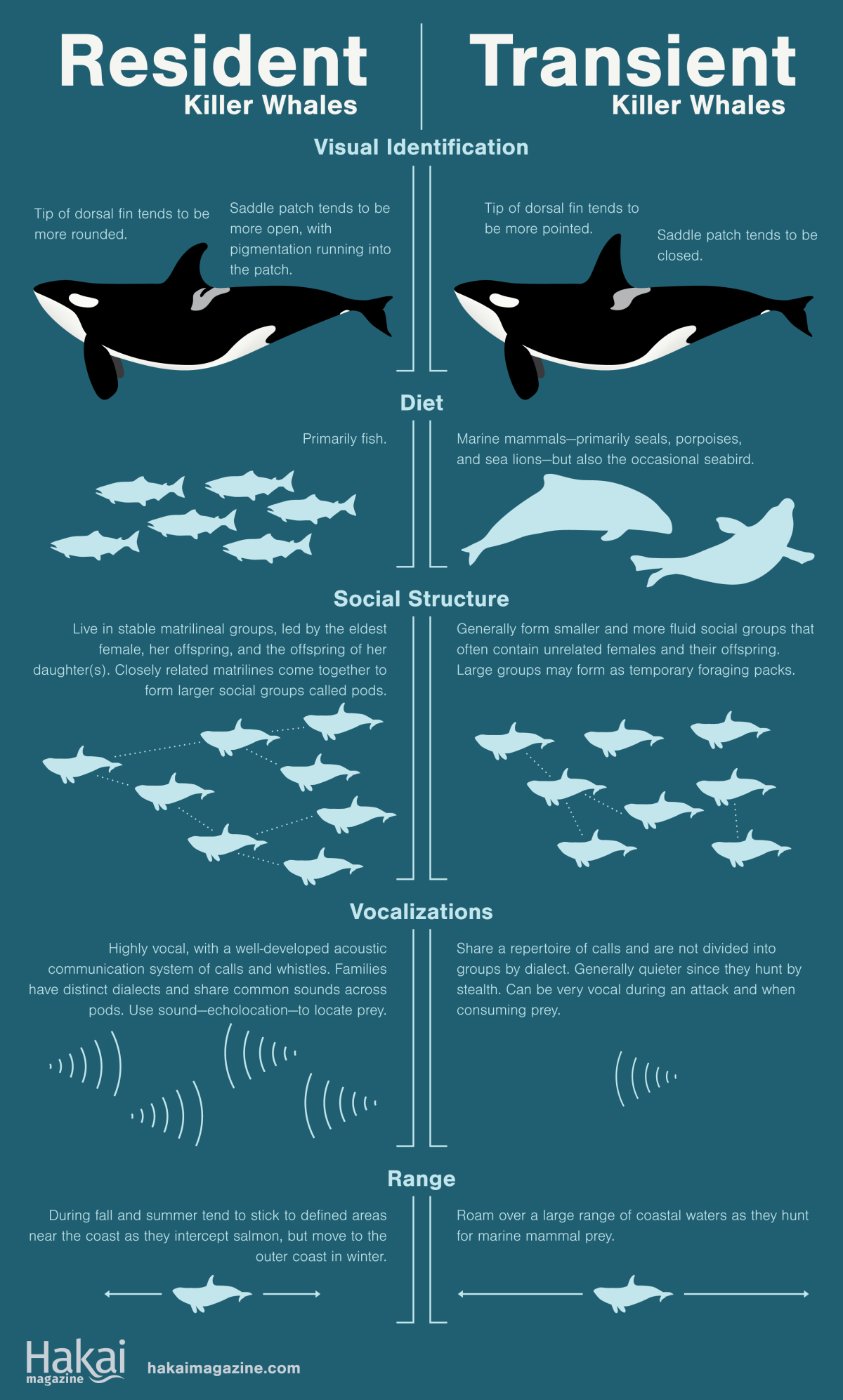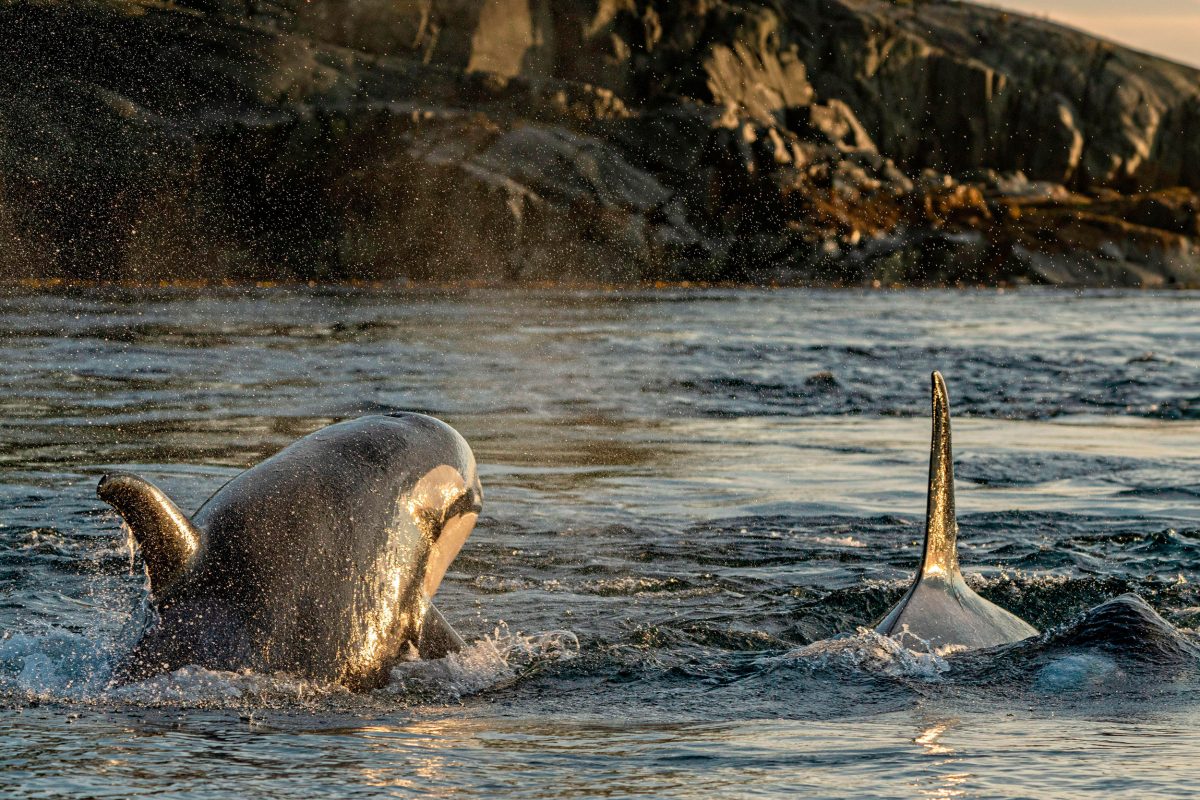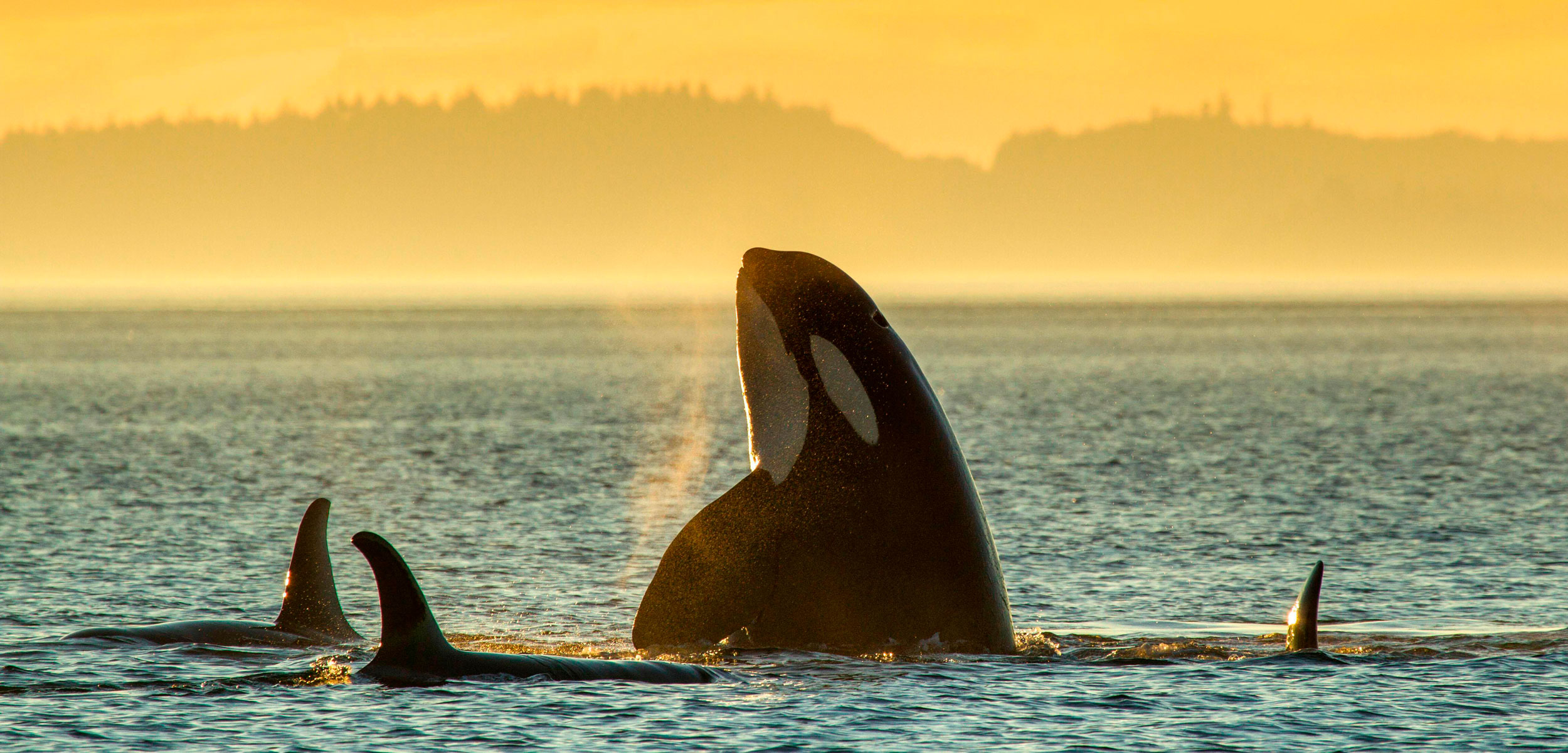Meet the Killer Whales You Thought You Knew
The iconic marine mammals may not belong to one species but several. Surprise!
Article body copy
John Ford still recalls the first time he heard them. He’d been puttering around the Deserters Group archipelago, a smattering of spruce- and cedar-choked islands in Queen Charlotte Strait, between Vancouver Island and mainland British Columbia. He was piloting a small skiff and trailing a squad of six killer whales. Ford, then a graduate student, had been enamored with cetacean sounds since listening to belugas chirp while he worked part-time at the Vancouver Aquarium as a teenager. Now here he was, on August 12, 1980, tracking the underwater conversations of wild killer whales through a borrowed hydrophone.
Ford had spent the previous two summers painstakingly recording the sounds made by other groups of these iconic black-and-white marine mammals, known as resident killer whales. In summer and fall, the residents traveled in noisy, tight-knit pods that often hugged the shorelines of British Columbia and Washington State, breaching in spectacular aerial displays that delighted tourists, scientists, and other bystanders. They emitted rapid overlapping clicks and thumps, along with squeals, honks, and bleats that could resemble seal barks or, occasionally, human flatulence.
Yet to Ford, the vocalizations he captured on his reel-to-reel that August day sounded nothing like the resident killer whales he’d recorded in previous years. They were coming from a gang of whales researchers had taken to calling “the oddballs,” because they appeared to scientists to be social outcasts who had left or been driven out of the resident group. Their calls were tonal, more alien, and far louder, sometimes sounding like a rusty hinge on a closing gate. Clicks were infrequent when they came at all. “I was amazed,” Ford says now.
While Ford spent the rest of his career studying whales, eventually leading the cetacean research program for Fisheries and Oceans Canada’s Pacific Biological Station before retiring in 2017, he never forgot his reaction that day: these must be different creatures.
Different ecotypes of killer whales have long been known to have distinct vocalizations. The first recording is of resident killer whales; the second features transient, or Bigg’s, killer whales. Audio courtesy of John Ford
More than 40 years later, science is poised to agree.
A new study published today in the journal Royal Society Open Science by a team of top whale experts argues that across the North Pacific, resident killer whales and the oddballs—long since renamed transient, or Bigg’s, killer whales—aren’t just different ecotypes. They’re entirely distinct species. The researchers contend that both are separate from a third species that encompasses the rest of the world’s killer whales.
Ford, who was not involved in the study, calls the research thorough and definitive, drawing from data collected across disciplines and over decades. “There’re just pieces of the story that have fit together to build, I think, a compelling case,” he says.
By proposing to split Orcinus orca into three separate species—residents, transients, and everything else—scientists aren’t only changing the taxonomic record to more accurately reflect what it means to be a killer whale. They’re also acknowledging the ways that communication, behavior, and even culture can help shape speciation as surely as genetics and physiology do.
Killer whales traverse all the world’s oceans, from polar waters to the tropics. They are the seas’ apex predators, described in scientific literature in 1869 as “wolves of the ocean,” who swim “in small companies” while “living by violence and plunder.” That’s true. Some killer whales eat birds or baby whales or balls of herring. Others prey on manta rays or sea turtles. In Antarctica, they work together to wash seals off ice by swamping floes with waves. In both hemispheres, killer whales have been seen surging onto beaches to pluck seals right off land.
There have long been signs that such hunting behaviors and dietary differences might be more than mere preference. In 1970, whale rustlers herded several killer whales into Pedder Bay, southwest of Victoria, British Columbia, with the intent of capturing them for marine theme parks. For more than 11 weeks, two of the whales refused to eat the fish that handlers served them, becoming more and more emaciated. What no one knew then was that these captives were transients, not the resident killer whales who were known to specialize in chinook salmon as prey. Scientists didn’t yet understand that transients even existed, or that they’d eat seals, porpoises, dolphins, even humpback calves—but not fish.

Transient, or Bigg’s, killer whales, not only look, sound, and act differently than their resident killer whale neighbors, they might be an entirely different species. Danita Delimont Creative/Alamy Stock Photo
“These prey specializations aren’t just choices that orcas make on a daily basis—they are hardwired,” says Bob Pitman, a marine ecologist and affiliate of Oregon State University’s Marine Mammal Institute. In fact, both populations are so set in their ways that researchers have spied resident fish-eating whales slaughtering harbor porpoises for sport without consuming them.
For decades, scientists misunderstood these behaviors, which are consistent everywhere residents and transients are found, from California, British Columbia, and Alaska to Japan, Russia, and beyond. “We didn’t recognize that as being evolutionarily significant,” says Phillip Morin, a marine mammal geneticist with the National Oceanic and Atmospheric Administration (NOAA) Southwest Fisheries Science Center who led the Royal Society Open Science study.
By 2003, the population of one subsection of residents—the southern residents, often spied in and around the Salish Sea, which stretches from BC’s Strait of Georgia to Washington’s Budd Inlet—had plummeted to 83 individuals from an estimated high in the 19th century of more than 200. Scientists in the United States trying to advise the government on how to offer federal protections to these particular whales struggled to describe how they fit in with the rest of the world’s killer whales, and vice versa. Nor did scientists know how long members of a group struggling to survive had gone without breeding with other killer whale groups in the same area.
So Morin spent years coordinating with fellow experts, amassing evidence about the peculiarities of residents and transients across the North Pacific. Some elements had been known for decades. For instance, transients don’t just eat differently than residents, they hunt differently, too. Unlike their chatterbox neighbors, transients use stealth, and stalk meals in silence (likely because their prey use sound too). And while residents live in stable pods for decades, transients travel in looser groups with shifting alliances.

Although killer whales may look alike at first glance, their differences are so pronounced that residents and transients may not have interbred for hundreds of thousands of years. Illustration by Mark Garrison
Furthermore, killer whales often live in communities with their own rituals, which get passed down from one generation to the next through social learning. Even subgroups of resident whales that are nearly genetically identical and overlap geographically can behave quite differently, their dialects as unalike as Spanish and Japanese. Northern residents, for example, frequently zip into shallow waters to scratch their bellies on the gravelly seafloor. Southern residents, who frequent similar waters, have never been documented doing that. Instead, they hold multi-pod gatherings and occasionally push baby salmon with their snouts—neither of which is a popular pastime with northern residents.
Alone, none of these differences is enough to classify different communities or ecotypes as distinct species. But for some groups of killer whales, what started out as behavioral traits handed down through generations may have ultimately helped lead to something more. “Most people tend to think [something is] either a different species or it’s not,” Pitman says. But “you have to understand: evolution is a slow change over time. It’s not a black-and-white situation.”
Over several decades, Morin’s compilation of research helped illuminate differences both subtle and extraordinary, through methods as diverse as finding and studying whale skulls and using cameras attached to drones. Transients, compared to residents, are longer and fatter, with more triangular dorsal fins. Their jaws are more robust and curved—a necessity, perhaps, for wrangling a half-tonne dinner of Steller sea lion.
But some of the most compelling distinctions come from work by Morin and colleague Kim Parsons, a research geneticist at NOAA’s Northwest Fisheries Science Center. When studying tissue samples, Parsons found that whenever whales look, act, feed, and sound like transients, they have DNA that’s noticeably distinct from residents. In fact, Morin’s work showed that the two whale types, even when swimming in nearby waters, are so genetically removed from one another that they haven’t interbred for at least several hundred thousand years. As Parsons puts it: “They’ve obviously been on very separate, very divergent, and independent paths of evolution for a very, very long time.”
This pattern remains true across the North Pacific. Andrew Foote, an evolutionary biologist at the University of Oslo who has studied killer whales but wasn’t part of this study, says that this speaks to how robust the barriers to gene flow are between residents and transients.

In the near future, resident killer whales like these may be considered a distinct species. Photo by Rolf Hicker Photography/Alamy Stock Photo
Morin’s best guess is that as ice ages came and went, groups of whales became isolated by changing geography and were forced to specialize. “There was this physical separation, which is the normal way that speciation starts to occur, and the cultural variation was overlaid on top of that,” Morin says. When the environment shifted again and whales came back together, “cultural differences reinforced the separation.”
Other animals that separated for millennia then reunited might not have a problem reintegrating, Morin adds. But killer whales have such cohesive family bonds and distinct dialects that “this cultural aspect helps drive their divergence—or at least helps maintain it.”
For the moment, killer whales globally will remain a single species. The Society for Marine Mammalogy’s taxonomy committee will debate the findings of Morin and his colleagues, maybe later this spring, and many experts suspect they will eventually accept the proposed partitioning of killer whales into three species: transients (Orcinus rectipinnus), residents (Orcinus ater), and everything else, including the offshore whales that also call the North Pacific home. All of those would still go by Orcinus orca—at least for now. This research may eventually pave the way for further divisions among the rest of the planet’s killer whales.
In the meantime, Ford looks forward to being able to finally settle a longstanding argument. “What this paper is going to do is resolve a problem I’ve had for years,” he says, chuckling. When he talks to the public highlighting differences between these whales, or tells someone at a dinner party how he spent his career, he invariably faces a question: “Why aren’t they different species?”
Now he can say, “I think they will be soon.”

